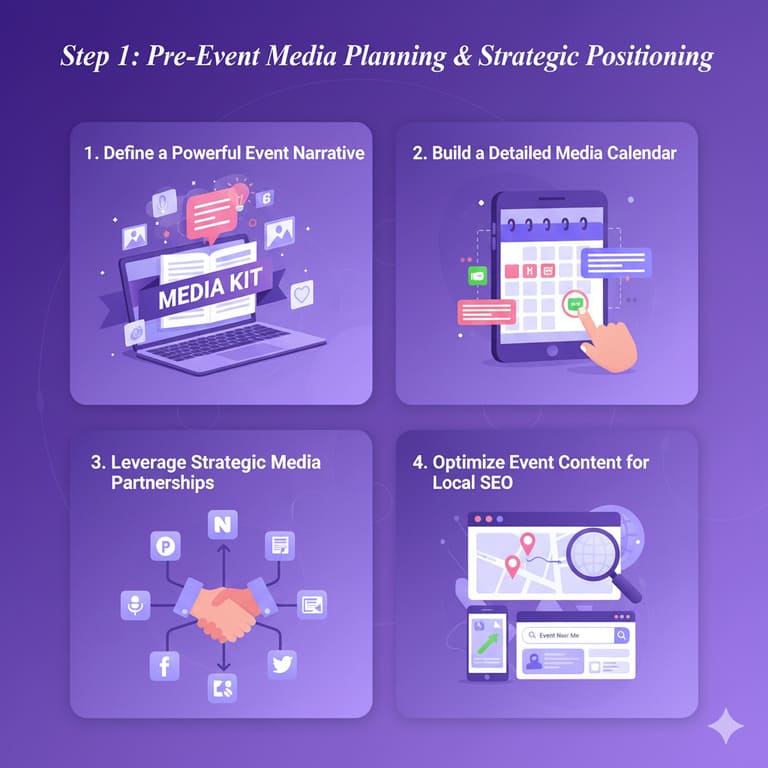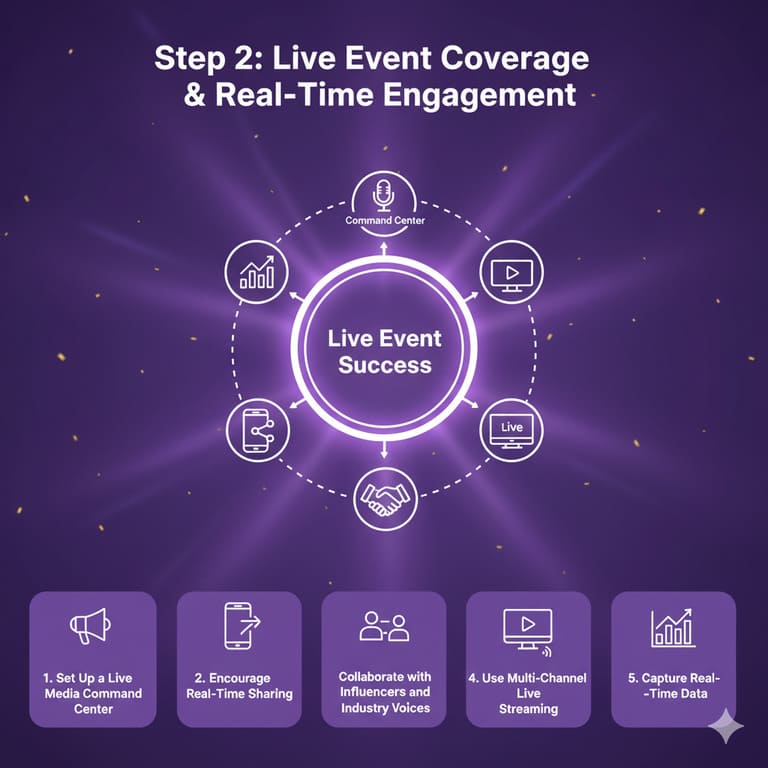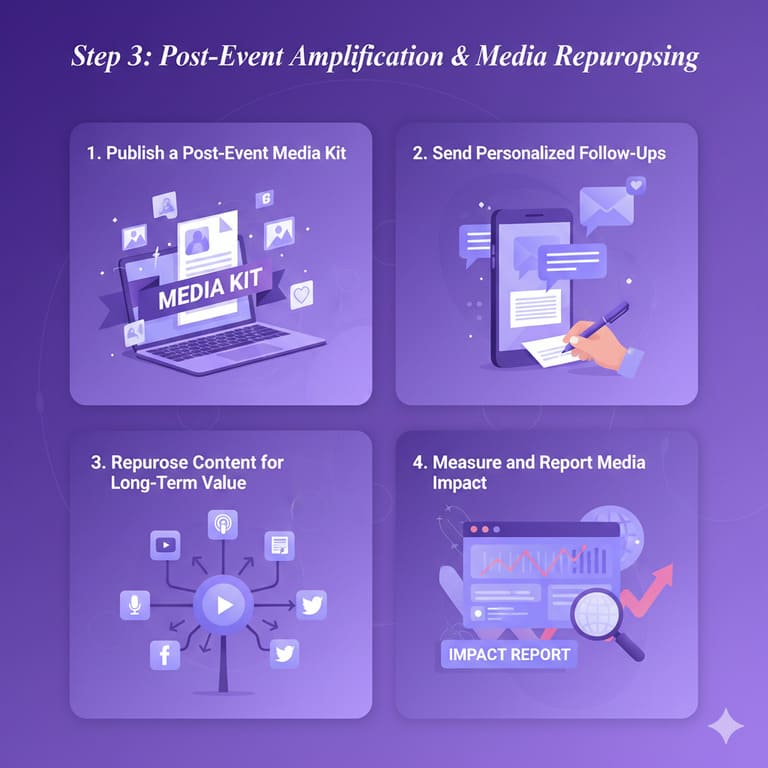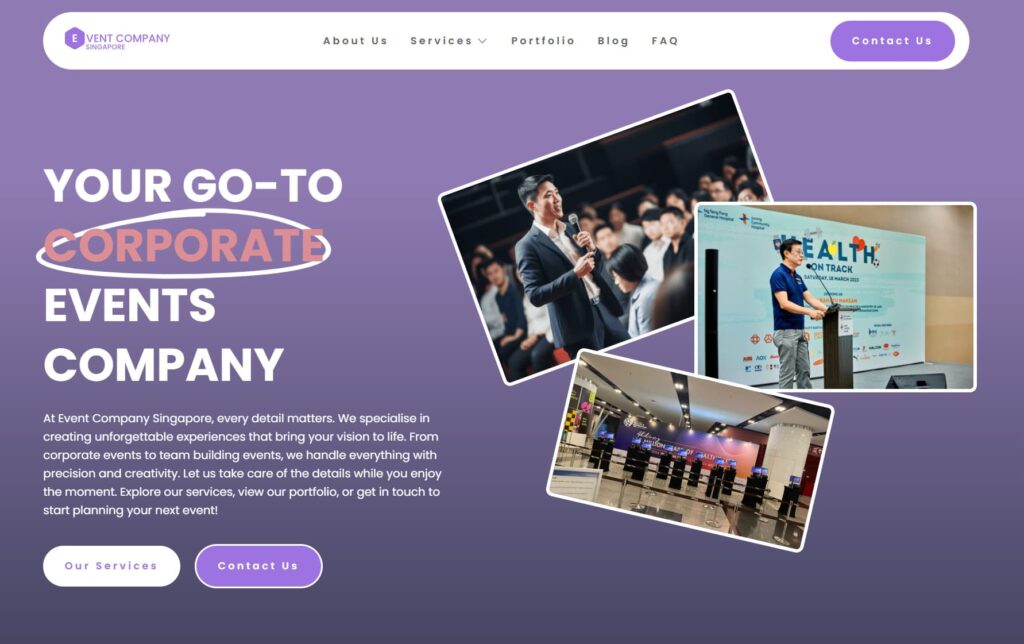Why Media Buzz Defines Event Success Today
In Singapore’s fast-paced corporate landscape, events are no longer just gatherings — they’re powerful stages for brand storytelling. Whether it’s a leadership summit, product launch, or corporate anniversary, the success of your event depends not only on attendance, but on how well it captures public attention.
Creating media buzz isn’t luck. It’s a calculated strategy that blends storytelling, branding, and digital amplification. The best corporate event organizers in Singapore know how to turn a private event into a public sensation — generating media coverage, viral posts, and brand momentum long after the last guest leaves.
This article reveals the 3-step media strategy every organizer must master to make your corporate event stand out — before, during, and after it happens.
Step 1: Pre-Event Media Planning & Strategic Positioning

In the world of corporate events, the success of your media campaign starts long before the event day itself. This is where strategic planning, storytelling, and targeted communication combine to create anticipation and media excitement.
For any corporate event organizer in Singapore, mastering this pre-event stage is what separates a well-run event from one that truly makes an impact across press, social media, and professional networks.
1. Define a Powerful Event Narrative
Every event must tell a story. Before inviting guests or sending out a single press release, take time to define your core narrative — the message that ties your event to your brand’s vision and audience interests.
Ask yourself:
- What is the core message you want your audience to remember?
- Why is this event happening now? Does it respond to a new trend, innovation, or milestone?
- How does this event align with your company’s mission, culture, or brand promise?
“The most successful events are not just well-planned — they’re well-positioned.”
This narrative should form the emotional and strategic foundation for all your marketing materials, from teaser videos to speeches.
Example:
If your brand is focused on sustainability, emphasize that in your story — showcase eco-conscious event design, green catering partners, and CSR collaborations with local environmental groups. This narrative not only strengthens your brand identity but also attracts media attention from publications and audiences who value corporate responsibility.
A corporate event organizer in Singapore can help articulate this narrative through brand workshops, creative concept development, and storytelling alignment with your broader marketing campaigns.
2. Build a Detailed Media Calendar
Once your event story is clear, it’s time to structure the timeline of communications that will build momentum toward the big day. A professional event organizer doesn’t leave exposure to chance — they plan it week by week.
Here’s a proven 8-week media calendar framework to maximize visibility:
| Timeline | Activities | Objective |
| Weeks 1–2 | Teaser announcement, save-the-date posts, initial press release | Generate curiosity and establish event presence |
| Weeks 3–4 | Influencer collaborations, behind-the-scenes videos, social snippets | Build engagement and shareable anticipation |
| Weeks 5–6 | Speaker introductions, interview releases, thought leadership articles | Strengthen authority and credibility |
| Weeks 7–8 | Final media reminders, RSVP confirmations, paid ad campaigns | Drive final attendance and press confirmations |
Each phase of the plan should be carefully coordinated with your internal PR and marketing teams. Remember — consistency matters more than frequency. Regular, relevant communication across multiple channels creates familiarity and keeps your brand top-of-mind.
A corporate event organizer Singapore with media relations expertise can also ensure press materials are aligned with local media schedules and editorial calendars, increasing your chances of being featured.
3. Leverage Strategic Media Partnerships
Media partnerships are a cornerstone of pre-event promotion. Collaborating with the right publications and platforms extends your visibility far beyond your existing audience.
Identify Your Ideal Media Mix:
- Mainstream Singapore Media: The Straits Times, Channel News Asia (CNA), Marketing Interactive
- Business & Trade Publications: Business Times, Human Resources Online, SME Magazine
- Digital and Event-Specific Outlets: Event Marketer Asia, SG Event Hub, LinkedIn business communities
“Effective media partnerships are not just about coverage — they’re about credibility.”
Offer journalists exclusive previews, such as early access to speakers, VIP interview opportunities, or product reveals. Providing value to media outlets makes your event newsworthy rather than promotional.
You can also collaborate with industry influencers or thought leaders who align with your event’s theme. Their authentic voices often generate more engagement than traditional ads.
Moreover, always prepare a press kit containing your brand story, event highlights, key visuals, and company profile — ensuring that any reporter or partner can quickly access accurate, media-friendly information.
4. Optimize Event Content for Local SEO
Even the most creative event won’t succeed if no one can find it online. That’s where search engine optimization (SEO) plays a vital role.
In Singapore, where digital search and social media behavior are highly localized, your event content should be optimized for local intent. This ensures visibility among the right audience — business professionals, corporate decision-makers, and journalists.
SEO Checklist for Corporate Events:
- Use high-value keywords naturally throughout your content — e.g.:
- “corporate event organizer Singapore”
- “business event Singapore”
- “company launch Singapore”
- Create SEO-friendly event pages with structured data, clear meta tags, and schema markup for events (Google recognizes these and displays them in search results).
- Update your Google Business Profile with event details, including venue, date, and booking information.
- List your event on reputable online directories like Eventbrite, TimeOut Singapore, and Facebook Events for additional backlinks.
- Optimize images and videos: rename files (e.g., “corporate-event-singapore-keynote.jpg”) and include descriptive alt-text.
- Link strategically: connect your event page to relevant service or product pages on your website to boost domain authority.
Remember: media visibility begins with search visibility.
An event that’s easy to find online is far more likely to be picked up by both guests and journalists.
See More: How to Plan an Unforgettable Awards Ceremony That Inspires Your Team
Step 2: Live Event Coverage & Real-Time Engagement

In today’s hyperconnected world, every successful corporate event extends beyond the physical venue — it lives online, in real-time. The best corporate event organizers in Singapore know how to transform live experiences into digital spectacles that generate buzz, engagement, and visibility far beyond the room.
This stage of your media strategy focuses on turning moments into movements — by amplifying your event as it happens through live media, social sharing, and digital storytelling.
1. Set Up a Live Media Command Center
A modern corporate event is both an on-site experience and a digital broadcast. To manage this dual presence effectively, establish a live media command center — either as a booth on-site or a remote control room staffed with PR, content, and digital marketing specialists.
Your media command center should handle:
- Live social media posting across platforms like LinkedIn, Instagram, and Facebook.
- Hashtag tracking (e.g., #SingaporeEvent #YourBrandSummit2025) to monitor audience engagement.
- Influencer tagging and reposting to amplify your reach in real time.
- Responding to media inquiries instantly, ensuring journalists receive accurate updates.
“Real-time storytelling turns your event from a private moment into a public narrative.”
This setup allows for controlled, consistent communication and ensures your brand voice stays cohesive while the event unfolds. A corporate event organizer Singapore can provide the technical and creative team to handle this seamlessly, ensuring no opportunity for media exposure is missed.
2. Encourage Real-Time Sharing
Your attendees are your best ambassadors — empower them to share their experiences live. Every photo, story, and hashtag post contributes to your event’s online footprint.
Here’s how to encourage natural participation:
- Create photo-worthy installations featuring your logo, slogan, or campaign tagline.
- Offer strong Wi-Fi and charging stations — people are more likely to post when they can connect easily.
- Host engagement contests, such as “Most Creative Post Wins a Gift” or “Top LinkedIn Photo of the Day.”
People don’t just attend events — they broadcast them.
Encouraging attendees to share authentic content not only boosts engagement but also provides you with user-generated material for future marketing. A well-prepared event organizer will plan these “share moments” into the event layout — such as branded walls, media-friendly lighting, and visually appealing backdrops.
3. Collaborate with Influencers and Industry Voices
In Singapore’s corporate scene, credibility often comes from authentic voices, not just big media headlines. That’s why partnering with micro-influencers and respected industry figures is key to amplifying your event’s reach.
Micro-influencers often enjoy stronger audience trust and higher engagement rates. They can:
- Live-stream event segments, sharing valuable insights with their followers.
- Conduct speaker interviews, adding personality and behind-the-scenes perspectives.
- Post real-time reviews and takeaways, driving conversation around your event theme.
“Influencer storytelling transforms brand messages into relatable experiences.”
For example, at a fintech conference, collaborating with local LinkedIn creators who specialize in innovation and business leadership can spark discussions among decision-makers. A professional corporate event organizer Singapore can identify the right influencers, negotiate collaborations, and manage influencer relations for smooth execution.
4. Use Multi-Channel Live Streaming
Not everyone can attend your event in person — but with the right streaming setup, your reach can multiply tenfold. Broadcasting select parts of your event live gives remote audiences a seat at the table while driving continuous engagement.
Here’s how to choose the right channels:
- LinkedIn Live: Best for professional audiences and B2B engagement. Ideal for conferences, seminars, or panel discussions.
- YouTube Live: Perfect for long-form broadcasts like keynotes, product launches, and brand showcases.
- Instagram Stories or Reels: Capture quick, authentic behind-the-scenes moments that feel human and real.
- TikTok Live: For younger or creative audiences, highlight interactive, entertaining moments.
During live sessions, keep audiences involved through:
- Polls and Q&A sessions to make viewers part of the event conversation.
- Live chat moderation to answer questions instantly.
- On-screen visuals and branded overlays to maintain brand consistency.
“Every minute of live coverage is a media opportunity — treat it as prime time.”
A skilled corporate event organizer in Singapore will coordinate both the technical and narrative aspects — ensuring lighting, camera angles, and sound quality all align with brand aesthetics and media standards.
5. Capture Real-Time Data
Real-time coverage isn’t just about engagement — it’s about insights. The data you collect during the event becomes the foundation for your post-event media and marketing strategy.
Track key metrics such as:
- Hashtag reach and impressions: How far did your branded conversation travel?
- Social mentions: Which platforms generated the most buzz?
- Live viewers and watch time: How long did audiences stay engaged?
- Engagement rate: Which posts, videos, or segments resonated most with the audience?
“Data turns your event buzz into measurable business value.”
By analyzing this information, you can identify what worked, what to amplify next time, and how to refine your post-event outreach. This level of reporting is essential for proving ROI to sponsors, partners, and internal stakeholders.
See More: How to Plan an Unforgettable Awards Ceremony That Inspires Your Team
Step 3: Post-Event Amplification & Media Repurposing

1. Publish a Post-Event Media Kit
Within 48 hours, distribute a media kit including:
- Press release summarizing event highlights
- High-quality photos and videos
- Quotes from executives or special guests
- Social media recap links
This ensures immediate follow-up coverage and positions your event as professionally managed and media-friendly.
2. Send Personalized Follow-Ups
Thank your attendees, partners, and journalists personally:
- Send tailored emails with “Top 5 Highlights You Missed”
- Offer exclusive access to the recorded keynote or eBook summary
- Share links to the event photo gallery
Building post-event relationships is essential to maintaining brand goodwill and securing future coverage.
3. Repurpose Content for Long-Term Value
Turn event content into ongoing marketing material:
- Edit key speeches into short educational videos
- Convert presentation slides into blog posts
- Use audience testimonials in your next campaign
By repackaging your media assets, your event continues to generate ROI months after it ends.
4. Measure and Report Media Impact
Use analytics tools like Google Analytics, Meltwater, and Hootsuite to measure:
- Media reach and backlinks
- SEO ranking improvements
- Engagement rate and lead generation
Create a detailed Media Impact Report to share with stakeholders, demonstrating clear results from your event marketing efforts.
See More: How Much Does It Cost to Hire an Event Management Company in Singapore?
Case Studies: How Top Singapore Organizers Create Buzz
Case 1: The Fintech Innovation Summit
A corporate conference hosted at Marina Bay Sands attracted 2,000 attendees. The organizers partnered with LinkedIn influencers and tech journalists.
Result: Over 50 media mentions, 10,000+ LinkedIn impressions, and coverage in The Business Times.
Case 2: CSR Launch by a Logistics Brand
A mid-sized logistics firm worked with a corporate event organizer Singapore to unveil its new sustainability program.
Result: Coverage by CNA Lifestyle and Green SG Journal, with the video reaching 20,000 views in two days.
Case 3: Luxury Product Launch
A luxury brand used immersive storytelling and influencer engagement.
Result: Social buzz that outperformed paid ads, with 15% increase in brand searches the following month.
Best Practices Every Corporate Event Organizer in Singapore Should Follow

In Singapore’s highly competitive corporate landscape, hosting an event that merely “runs smoothly” is no longer enough. A successful corporate event must generate media attention, strengthen brand credibility, and deliver measurable business outcomes. Whether you’re organizing a leadership summit, product launch, or client appreciation gala, these best practices will help ensure your event achieves both media impact and long-term brand success.
1. Align Media Goals with Business Objectives
Every press release, social post, and media partnership should serve a clear business purpose.
Before crafting your communication strategy, define what success looks like for your brand. Are you aiming to build awareness, attract new clients, or strengthen industry partnerships?
For example:
- A tech startup might focus on showcasing innovation to attract investors and partners.
- A luxury brand may prioritize exclusivity and high-profile media coverage to reinforce its prestige.
- A B2B corporate conference could aim to generate qualified leads or thought-leadership positioning.
Once goals are set, align your media metrics accordingly — track coverage reach, backlink quality, engagement rate, and conversion outcomes.
A professional corporate event organizer in Singapore will ensure every piece of publicity connects directly to measurable ROI.
2. Invest in Professional Visual Storytelling
In today’s content-driven world, high-quality visuals are the backbone of effective event marketing. Photos and videos are not just documentation — they are powerful storytelling tools that extend the life of your event long after it ends.
To stand out in Singapore’s competitive media environment:
- Hire photographers and videographers experienced in corporate events and PR coverage. They understand how to capture brand narratives, key moments, and audience energy that media outlets value.
- Plan signature visual moments, such as a grand stage reveal, live performance, or CEO keynote, designed specifically for press and social sharing.
- Use multiple formats — horizontal videos for YouTube and websites, vertical clips for Instagram Reels and TikTok, and square photos for LinkedIn posts.
Your event’s visual assets should be ready to repurpose across your digital ecosystem — from press releases and newsletters to paid ads and case studies.
Brands that invest in professional storytelling build stronger emotional connections and enjoy broader organic reach.
3. Localize Your Message for the Singapore Audience
Singapore is a unique blend of global sophistication and local identity. To connect authentically, your campaign message must reflect both.
Localizing your content doesn’t mean translating — it means understanding the values, culture, and communication style of your audience.
Consider integrating:
- Cultural nuances: Use references to Singapore’s innovation culture, smart-city vision, or sustainability goals.
- Local partnerships: Collaborate with Singapore-based influencers, business chambers, or universities to boost credibility.
- Relevant examples: Frame discussions around current Singapore business trends — such as digital transformation, sustainability, or workforce innovation.
For example, an event themed “Innovation for a Greener Tomorrow” could feature local green-tech startups or government sustainability initiatives.
When audiences see local relevance, engagement and media resonance increase significantly.
A skilled corporate event organizer in Singapore knows how to balance global brand identity with localized storytelling — a key ingredient for PR success.
4. Integrate Data Analytics Early in the Process
Data should guide every decision, from event promotion to post-event analysis.
By integrating analytics tools early, you can identify what resonates with your audience and refine your media approach in real time.
Start by tracking:
- Pre-event engagement metrics: Ad impressions, click-through rates, and landing page conversions.
- Audience demographics: Which industries, job titles, or geographic segments are showing the most interest?
- Engagement behaviors: Monitor which types of content — video teasers, interviews, or thought-leadership posts — perform best across platforms.
During and after the event, continue measuring:
- Hashtag performance and social mentions
- Website traffic spikes during event coverage
- Media pickup and backlink growth
- Lead generation or form submissions tied to event content
Data analytics transforms guesswork into strategy. When you understand audience behavior, you can make informed adjustments to future campaigns, allocate budgets effectively, and demonstrate quantifiable ROI to stakeholders.
This level of precision separates average event planning from strategic corporate event organization.
5. Maintain Brand Consistency Across All Channels
Every touchpoint — from the invitation email to the post-event press release — must reflect your brand’s tone, design, and values. Inconsistent messaging can dilute your credibility and confuse your audience.
Ensure that:
- Your brand voice remains consistent across media statements, website copy, and social posts.
- Your visual identity (logos, colors, typography) aligns across printed materials, banners, and digital visuals.
- Your messaging pillars reinforce key themes — innovation, trust, professionalism, or collaboration — throughout the campaign.
Singapore’s audiences, especially corporate decision-makers, notice precision and consistency. Cohesive communication reinforces your brand’s reputation and strengthens long-term recognition.
6. Prepare for Media Responsiveness
During high-profile corporate events, journalists and influencers may request interviews, quotes, or press clarifications. Being prepared and responsive can make or break your coverage.
Develop a media response protocol:
- Designate a media liaison to handle all inquiries and ensure accurate information delivery.
- Prepare media briefing documents that summarize event objectives, speaker bios, and brand key messages.
- Offer exclusive access or interviews to priority publications for deeper feature opportunities.
Timely responses and well-prepared talking points demonstrate professionalism — one of the reasons brands prefer working with experienced corporate event organizers in Singapore who understand local media etiquette and standards.
7. Create Opportunities for Thought Leadership
Corporate events aren’t just about networking or celebration; they’re platforms to establish thought leadership.
Position your brand’s leaders and speakers as credible voices in your industry by:
- Hosting panel discussions on current market challenges or innovations.
- Publishing pre- and post-event articles authored by your executives.
- Sharing insights from your keynote sessions across LinkedIn and business media platforms.
When done strategically, your event doesn’t just attract attention — it shapes conversations and strengthens your authority in Singapore’s business community.
8. Evaluate and Refine Continuously
Finally, the best event organizers treat every project as part of an ongoing improvement cycle.
Conduct detailed post-event evaluations that assess:
- Achievement of key performance indicators (KPIs)
- Audience satisfaction and feedback
- Media effectiveness and engagement analytics
Use these insights to refine your planning process, messaging, and partnerships for future events.
Continuous improvement ensures that every event you host becomes more impactful, efficient, and aligned with evolving business goals.
See More: Top Event Management Companies in Singapore for 2025: Who Delivers the Best Experience?
Q&A About Event Media Strategy in Singapore
In Singapore’s fast-paced corporate scene, media strategy is the difference between an event that disappears after a day and one that dominates headlines for weeks. Below are seven frequently asked questions — and expert answers — every corporate event organizer in Singapore should know to maximize exposure, engagement, and long-term brand value.
1. Why does media strategy matter for corporate events?
A strong media strategy determines whether your event stays private or becomes a public success story.
In Singapore’s competitive business landscape, earned media coverage on platforms such as LinkedIn, CNA, or The Straits Times can instantly elevate brand reputation, attract new clients, and position your company as a thought leader.
Without structured media planning, even well-executed events risk going unnoticed. With it, you can turn every product launch, leadership summit, or awards gala into a strategic branding opportunity that continues to generate visibility long after the event ends.
2. How early should you start media planning?
Ideally, begin 6 to 8 weeks before the event date.
This timeline gives you enough lead time to:
- Craft your event narrative and core messaging
- Pitch your story to targeted journalists and media outlets
- Secure partnerships with influencers or brand ambassadors
- Develop teaser campaigns and press materials optimized for SEO
Early planning allows you to position your event as newsworthy, ensuring your story is well-timed with Singapore’s media calendar and not lost amid other business events.
3. What media platforms perform best in Singapore?
The best-performing platforms depend on your target audience and event type.
- For B2B or professional events, LinkedIn and The Business Times are most effective for thought leadership and corporate credibility.
- For lifestyle, CSR, or creative brand activations, platforms like Instagram, CNA Lifestyle, and TikTok capture a wider and more visual audience.
- For technology or innovation-focused events, consider Tech in Asia and Marketing Interactive to reach niche, high-value audiences.
The key is to diversify: combine traditional PR with digital storytelling to amplify reach and engagement.
4. How can smaller events still generate buzz?
Even without a massive budget, smaller corporate events can still make an impact through strategic storytelling.
Here’s how:
- Define a unique angle — such as sustainability, innovation, or community impact — that resonates emotionally with your audience.
- Share relatable success stories or behind-the-scenes insights that humanize your brand.
- Partner with micro-influencers or local business communities who can share authentic, localized experiences.
When executed well, an intimate event with the right story can outperform larger productions in engagement and authenticity.
“In Singapore’s media ecosystem, attention favors authenticity over scale.”
5. What metrics should organizers track?
To evaluate your event’s media success, track both quantitative and qualitative metrics that show visibility and engagement. Key indicators include:
- Media mentions and backlinks from reputable publications
- Engagement rate (likes, shares, comments, video views) across social platforms
- SEO improvements, comparing keyword rankings before and after the event
- Website traffic spikes during event coverage
- Leads and conversions directly attributed to event content
Remember the rule: “What gets measured, gets improved.”
These metrics not only validate your results but also help refine your future media strategies.
6. How do you build long-term media relationships?
Media relationships should never end when the event does.
To nurture valuable partnerships:
- Provide exclusive insights or interviews before competitors.
- Follow up post-event with a thank-you note and downloadable press materials.
- Offer advance access to future events or newsworthy updates.
- Share meaningful statistics or outcomes from the event they covered.
Treat journalists and editors as collaborators who share your mission, not just as transactional contacts. A corporate event organizer in Singapore who builds trust and reliability will find media doors open faster with every new event.
7. What’s the best way to maintain post-event momentum?
The biggest mistake companies make is going silent after an event.
To sustain engagement and visibility, continue your media efforts for at least four weeks post-event through:
- Publishing recap videos and highlight reels on LinkedIn and YouTube
- Running “Thank You” campaigns to appreciate attendees and partners
- Re-sharing and tagging media coverage to extend its organic reach
- Posting thought-leadership reflections or “Key Takeaways” articles based on your event discussions
This ongoing visibility reinforces your brand authority and keeps your company top-of-mind for future opportunities.
In Singapore, momentum equals memory — keep your audience talking long after the event lights go out.
See More: Professional Award Ceremony Event Management Services for Your Business
Turning Every Corporate Event into a Media Masterpiece

A successful corporate event doesn’t end when the lights go out — it ends when the story fades. By mastering the 3-step media strategy — Plan, Engage, Amplify — your event can transcend time, reach new audiences, and position your brand as a leader in Singapore’s business community.
In an era where attention equals currency, media mastery is no longer optional — it’s essential.
That’s where expertise matters.
Partner with iCreationsLAB – Your Trusted Corporate Event Organizer in Singapore
At iCreationsLAB, we go beyond logistics.
We design media-driven event experiences that capture attention, inspire engagement, and build brand equity. From corporate galas and product launches to hybrid business events, our strategies ensure your story gets the spotlight it deserves.